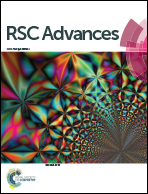Metal-centered monocyclic carbon wheel clusters with record coordination numbers in planar species†
Abstract
The highest coordination number identified to date in planar species is CN = 10 in metal-centered monocyclic boron wheel clusters D10h M©B10− (M = Ta and Nb) (Galeev et. al., Angew. Chem. Int. Ed., 2012, 51, 2101). Extensive global minimum searches and first-principles theory calculations performed herein indicate that the experimentally observed LaC13+ and LaC14+ possess the well-defined global minima of perfect metal-centered monocyclic carbon wheel D13h La©C13+ (1)  and slightly off-centered C2v La©C14+ (4) (1A1) with record coordination numbers of CN = 13 and 11 in planar structures, respectively, further pushing the boundary of our understanding of chemical structures and bonding. Detailed molecular orbital, nucleus-independent chemical shift, and ring current analyses indicate that D13h La©C13+ (1) is σ + π dually aromatic in nature, with 14 totally delocalized in-plane σ electrons and 14 totally delocalized out-of-plane π electrons each matching the 4N + 2 aromatic rule (Nσ = Nπ = 3). Similar σ + π dually aromatic metal-centered monocyclic wheel clusters D13h Ca©C13 (2), C13v Ac©C13+ (3), C2v Y©B6C6+ (5), and C2v Sc©B5C6 (6) have also been obtained with CN = 13, 13, 12, and 11, respectively. The results obtained in this work effectively enrich the chemical structures and bonding patterns of planar hypercoordinated complexes.
and slightly off-centered C2v La©C14+ (4) (1A1) with record coordination numbers of CN = 13 and 11 in planar structures, respectively, further pushing the boundary of our understanding of chemical structures and bonding. Detailed molecular orbital, nucleus-independent chemical shift, and ring current analyses indicate that D13h La©C13+ (1) is σ + π dually aromatic in nature, with 14 totally delocalized in-plane σ electrons and 14 totally delocalized out-of-plane π electrons each matching the 4N + 2 aromatic rule (Nσ = Nπ = 3). Similar σ + π dually aromatic metal-centered monocyclic wheel clusters D13h Ca©C13 (2), C13v Ac©C13+ (3), C2v Y©B6C6+ (5), and C2v Sc©B5C6 (6) have also been obtained with CN = 13, 13, 12, and 11, respectively. The results obtained in this work effectively enrich the chemical structures and bonding patterns of planar hypercoordinated complexes.



 Please wait while we load your content...
Please wait while we load your content...